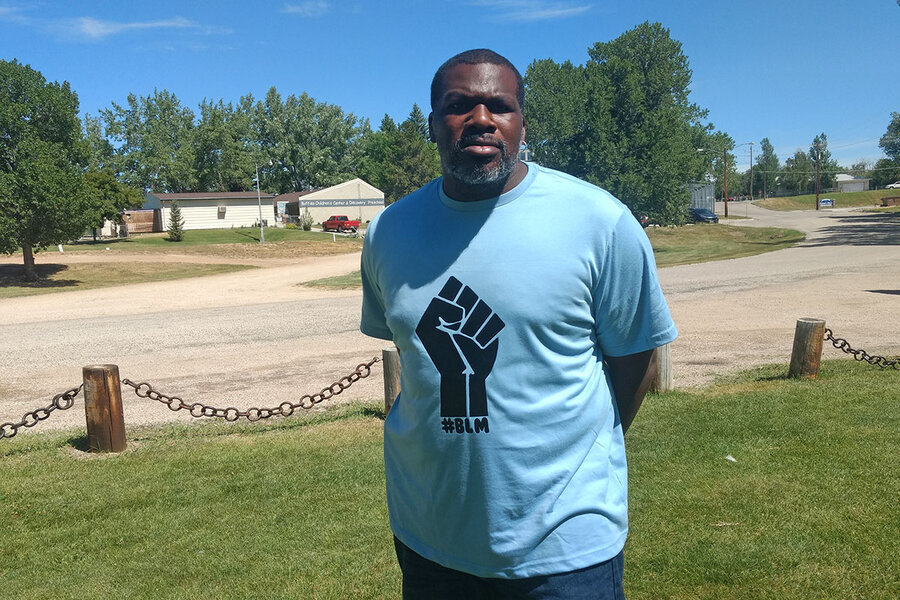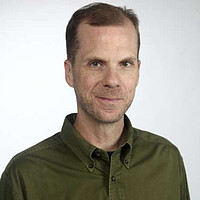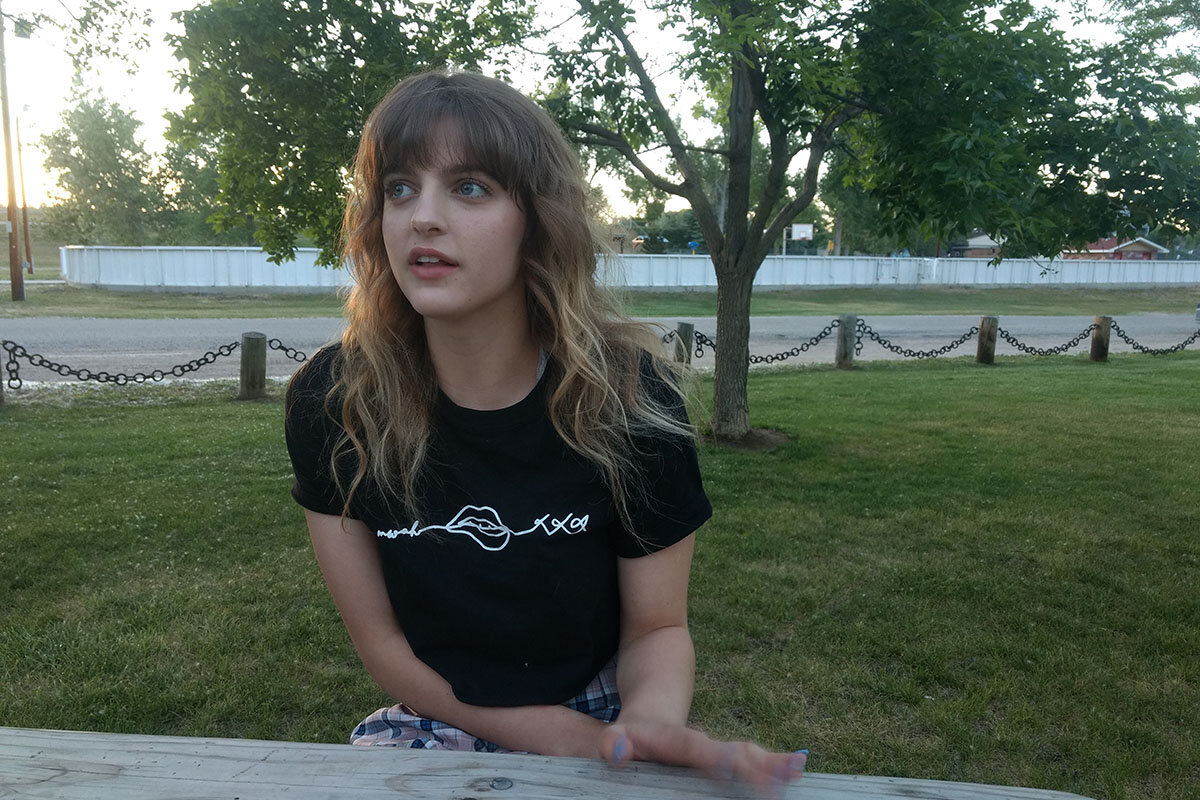‘We need to keep speaking out’: Racial justice in rural America
Loading...
| Buffalo, Wyoming
The latest census data for this Old West town tucked into the foothills of the Bighorn Mountains counts 31 Black residents among its population of almost 4,600. Kevin Thomas figures he knows at least half of them.
“It’s not hard,” he says. “When you’re Black in small-town Wyoming, you’re aware of one another.”
Mr. Thomas, a Texas native, moved to Buffalo a decade ago, seeking distance from the drugs and violence that ensnared him in his hometown of Galveston. A husband and father, he has steadied his life here, working as a nursing assistant and running a landscaping business.
Why We Wrote This
What does it mean for small towns like Victor, Idaho, and Buffalo, Wyoming, to hold Black Lives Matter protests? It's a groundswell of support not seen since the civil rights era.
Given that 9 out of 10 residents are white in his adopted town, Mr. Thomas never expected its streets to provide the backdrop for a protest in support of Black Lives Matter and racial justice. Three weeks ago, when he learned of a planned demonstration only a couple of hours ahead of time, he rushed home to round up his two children.
They donned T-shirts showing a raised fist above the hashtag #BLM and joined more than 75 people to march a half-mile from the county justice center to the town square. Nearly all of their fellow protesters were white.
“I was ecstatic,” Mr. Thomas says. “The fact that you have white folks who are willing to do this without understanding or experiencing what we experience as Black people – for them to speak up for us? It was empowering.”
If modest in size, the rally reflected the extraordinary breadth of the grassroots movement against police violence and racial inequality in the aftermath of George Floyd’s death in Minneapolis on Memorial Day. Unlike other large-scale demonstrations since the Vietnam War, the ongoing protests have spread beyond urban centers to outer suburbs and small towns in all 50 states, with an estimated 15 million to 26 million people taking part in more than 2,500 municipalities.
The groundswell has swept across rural America, where about 80% of the population is white, inspiring protests in unexpected locales, including Victor, Idaho (pop. 2,300), Atoka, Oklahoma (pop. 3,100), and South Royalton, Vermont (pop. 700). In Wyoming, the country’s least populous state, hundreds of demonstrators turned out last month in Riverton (pop. 11,000), Cody (pop. 9,800), and Pinedale (pop. 1,900).
High school and college students, their academic pursuits slowed by the pandemic, have organized many of the rural protests and injected urgency into the cause. Their desire to promote racial justice in small towns – defying threats and derision from counterprotesters who they know as classmates, co-workers, and neighbors – reveals an audacity that experts in social movements predict could deliver historic change.
“White people, and especially young white people, are using their privilege to make their voices heard in rural parts of the country,” says Sharon Elise, a professor of sociology at California State University, San Marcos. “They live in small towns or grew up there, but they don’t want to feel isolated. They want to connect to this bigger movement and have equality – true equality – for all people.”
“Silence sustains the status quo”
In early June, Rowan Heil and two friends drove a half-hour from Buffalo to Sheridan, a city of nearly 18,000 people, to attend a Black Lives Matter protest that drew some 500 marchers. The trio of teenagers found strength in the display of solidarity and returned home determined to bring the movement to Buffalo.
“To be white in America is to be privileged. But a lot of white people haven’t realized that or are just starting to,” says Ms. Heil, who graduated high school in May. “I want people of color to live in a world where they have the same choices and opportunities that I do.”
She announced plans for the protest on Facebook and received dozens of supportive responses. Several others attacked her. The hostility soon migrated offline as customers at her restaurant job accused her of trying to incite violence and drivers honked as they roared past her home late at night. Their reaction reaffirmed her conviction.
“People here say, ‘Racism exists because we talk about it too much,’” she says, shaking her head. She mentioned racial disparities in income, education, and housing, the higher incarceration rate of people of color, and the greater toll of the pandemic on minorities. “Silence sustains the status quo, and the status quo benefits white people.”
Ms. Heil notified police of the march, and officers in squad cars created a moving cordon to buffer the demonstrators, a mix of preteens, high school students, parents, and seniors. The group departed the justice center with Ms. Heil carrying a handmade sign that quoted Martin Luther King Jr.: “Injustice anywhere is a threat to justice everywhere.” Others held signs that read “We Stand With You” and “We All Must Do Better.”
Twenty minutes later, they reached the town square, where protesters took turns addressing the gathering from a stage, their individual messages bound by a common appeal for racial unity. A handful of counterprotesters in pickup trucks, some flying Confederate battle flags, drove past and revved engines as they attempted to drown out the speakers. A small group of bystanders shouted “All lives matter!” and “Trump 2020!” The crowd answered with “Black lives matter!” and “Wyoming is love!”
The march exposed the fraught personal dimensions of small-town activism, even without descending into physical conflict as occurred at a rally in Bethel, Ohio (pop. 2,800). Ms. Heil spotted former classmates among the counterprotesters. Police Chief Jason Carder, whose son graduated with her, saw teenagers and parents he recognized in both groups as he watched over the gathering.
Mr. Carder understood that the protesters sought to call attention to racial inequality rather than sow anti-police sentiment, and he viewed the efforts of Ms. Heil and her friends through the lens of generational change. “Young people today are aware of what’s happening around the country, and some of them want to be part of that,” he says. “So in some ways, it isn’t surprising we would have a demonstration.”
Following the speeches, protesters knelt in silence for 8 minutes and 46 seconds – the length of time that a Minneapolis police officer knelt on Mr. Floyd’s neck as two other officers pinned him down and a fourth stood watch. Tears pooled in Meseret Tegenu’s eyes as she gazed across the square.
The Wyoming native has gained painful familiarity with day-to-day racism in the “Equality State” – the stares, the slurs, the condescension. “It’s exhausting,” says Ms. Tegenu, the daughter of a Black father and white mother. “You feel like you’re being watched all the time.”
A landscape designer and the mother of two children, she stays in Wyoming for its natural beauty, mellow pace, and affordability. She moved to Buffalo a couple of years ago, and as a “stubborn optimist,” she retains hope that Ms. Heil’s generation and the rise of “woke” culture will push the state to fulfill its nickname.
“You have people here who will be super cordial to you but who don’t support Black Lives Matter or can’t understand why we need this movement,” she says. “I do think that in most cases they’re good people. They just need to be educated.”
Impatient hopefulness
A TV interviewer once asked Morgan Freeman how the country could end racism. “Stop talking about it,” the actor replied.
Buffalo Mayor Shane Schrader, who avoided last month’s protest, invoked Mr. Freeman’s line of thinking as he discussed the arrival of the Black Lives Matter movement to his town. At the same time, he adds, “We can’t stay in our 5,000-person bubble forever. We have to realize there are things going on in the rest of the world that will affect us.”
The awakening in Buffalo and rural areas across the country illuminates the growing influence of Black Lives Matter, particularly among young adults. A recent New York Times/Siena College poll found that more than two-thirds of Americans ages 18 to 29 hold a “very favorable” impression of the movement.
As protests against racial injustice continue, the country has witnessed an eruption of activism reminiscent of the civil rights era, with two distinctions that hold potential to power an even broader movement.
“There are so many non-Blacks involved, and there’s so much happening in rural towns,” says Aldon Morris, a professor of sociology and African American studies at Northwestern University, and author of “The Origins of the Civil Rights Movement.” “We’ve never seen either of those before.”
Dr. Morris explains that white supporters served as foot soldiers in some of the period’s largest demonstrations, including the March on Washington in 1963 and the marches from Selma to Montgomery, Alabama, two years later.
But studies of the era show that Black activists provided most of the grassroots energy behind civil rights, and “that was even more true in rural areas,” he says. “White college students were involved in urban areas. There wasn’t a mass movement among whites in small towns.”
The protests of the past six weeks suggest a spirit of activism has taken root among young white adults in rural areas. Ms. Heil, who will study musical theater at the Savannah College of Art and Design in Georgia starting in the fall, embodies the new attitude.
“It’s up to my generation,” says Ms. Heil, who organized a #MeToo awareness campaign at Buffalo High School. “We need to keep speaking out. That’s the only way change will actually happen.”
Jamie Schlegel shares that resolve. An international relations student at the University of Southern California, she returned home to Sheridan amid the coronavirus outbreak. In late May, as unrest flared in Minneapolis and other cities over Mr. Floyd’s death, she felt disconnected from the moment.
She decided to channel her frustration into organizing a demonstration with a few friends. They expected 30 people to show up. The turnout exceeded 500, offering evidence that the cause of racial equality has resonated in rural America.
“This isn’t just an issue for cities, for New York and LA. It’s an issue everywhere,” Ms. Schlegel says. She regards the future of the movement with impatient hopefulness as Generation Z and millennials add racial justice to their “to solve” list that includes climate change, school shootings, and college debt.
“We’ve seen the lack of change from older generations,” she says. “So they can either choose to support us or step aside because we’re the ones who have to deal with all this for the next several decades.”
The ongoing protests have pressured cities and states to adopt police reforms and remove statues of Confederate leaders, the Founding Fathers, and Christopher Columbus. But Dr. Morris, who grew up in Mississippi under Jim Crow laws, cautions that the momentum will falter if young Americans fail to deliver their message from the streets to the voting booth.
“There’s reason for optimism that real change could happen,” he says. “But it would be naive to think change is inevitable. Elections will show whether the young generations are actually different from their parents.”
For the sake of his young son and daughter, Mr. Thomas, the Texas native who has found peace in Wyoming, wants to believe that racial equality lies ahead for the country.
During the march in Buffalo last month, two counterprotesters directed racial epithets at him. He remained calm in a way that had eluded him as a younger man, and a short time later, a pair of white women approached. They asked to hug him.
“My kids should be free to grow up in a culture where they don’t feel hated because they’re Black,” he says. “There’s a long way to go, but I do have hope.” He smiled. “I mean, if a protest can happen in Buffalo, there’s hope.”








